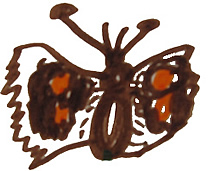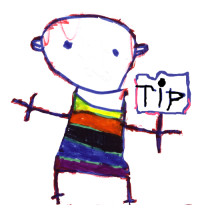Begin art education lessons by teaching your students basic art skills and organizing your art supplies in a way that makes less work for you.
Many young children have not had opportunities to explore elementary art materials and benefit from having daily art experiences. Children who express themselves with art gain small motor skills, gain confidence, practice making decisions, and transfer their art skills to other subject areas.
Use the lids from the boxes that photocopy paper comes in for quick and easy organization of art lessons, especially when putting supplies on tables for groups of kids to use.
The sides of the lids are high enough to keep the supplies from falling on the floor but low enough to allow the children to see and reach inside.
Keep crayons, scissors, paper, etc. organized by placing smaller boxes inside the lids to keep the items separated.
These box lids can be stacked and easily put out for an art center or for an art lesson. When the boxes get too tattered they are replaced.
Help children have more success by teaching them these art education basics…
Begin art education by teaching the basic skills of cutting, gluing, and painting listed below. Review them often at the beginning of the year and soon your students will be more independent when using the painting center, the art center, and the imagination station or when participating in an art education lesson.

Teach how to use white glue for gluing non-paper items
- Teach children that glue sticks work well with paper and white glue works well for non-paper items
- Put white glue in empty small jars like the ones that gift jams come in.
- Place small craft sticks in the jars. The small sticks make it difficult for students to use more than a little dab of glue at a time.
- Call the white glue “little dot glue” and teach the kids to use only little dots of white glue when creating their masterpieces.
- Teach students to keep the pot of glue very close to the area they are gluing so it does not drip across the table.
Glue stick practice!
- Keep the old ones from the previous year and use them in September to teach the kids how to use glue sticks.
- When the children have stopped experimenting with how they twist up and down, put out the new glue sticks!
Disappearing glue sticks are easier for little children as they can effortlessly see where they have applied the glue. This helps them not to smear it all over the place (mostly!!) The purple tone dries clear.
Painting with tempera blocks
Teach independence and make it easy for children to reach the sink, paper towels etc. Place the painting stations near the sink and keep wiping up rags and drying racks within easy reach.
 Tempera block tips!
Tempera block tips!
Remove all black blocks from the trays and keep in them in separate containers.
Wet the block paints 10 minutes before the children use them. The water will soak into the block and create brighter pictures.
One step at a time…
Teach the following steps repeatedly in September and the kids will soon be creating bright and colorful pictures.
Children:
- Get a paper from the pile
- Put their names on the back of the paper before painting.
- Fill a shallow margarine tub half full with water and carry it to the table
- Get a brush and check that it is clean.
- Put the brush in water and then in the tempera block and say, “Go around and around and around” to get lots of paint on the brush (otherwise children will get dull paintings).
- Hang their picture on the nearby drying rack
- Clean their brush, water pot, and table.
Easel painting
- All young children need experiences painting with pots of bright paint, large paper and big brushes
- Teach children to paint their name at the top of their paper.
- Teach students to use mixing brushes.
- First, the child puts red paint on with the brush from the red paint; blue paint on with the blue brush in the blue paint, and then uses a mixing brush to mix the colors right on the paper.
- Keep the mixing brush in a paint pot that has water in it.
- Color code brushes and paint pot lids if possible.
- Keep a drying rack close to the easel.
- Choose bright colors I love the Prang company colors the most, as they are fresh and clear looking. Some cheaper brands are very dull. Whatever you choose, check that they say non-toxic. Depending on where you live, you may have to choose a different brand.
Scissors
- Provide slightly stiff paper with straight lines on them to teach basic cutting (recycled envelopes from the school office work well).
- As children improve, put curving lines on the paper and finally zigzag lines.
- As they master basic cutting, give them regular paper to cut.
- Teach children to return scissors to the correct place and scissor safety.
- Cheap scissors are often dull and frustrate children. Choose a safe but well-made brand.
Experiment with color by limiting choices…
- Provide only yellow and blue paint for a few days. Let the students play.
- Another day put out only red and blue paint.
- Other days offer only white and red.
- Each day children take turns showing their pictures and talking about the colors they used and the new colors that they created.




